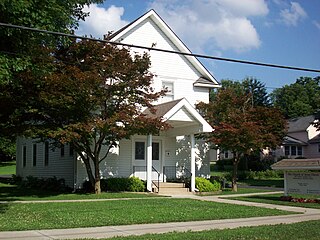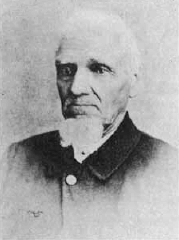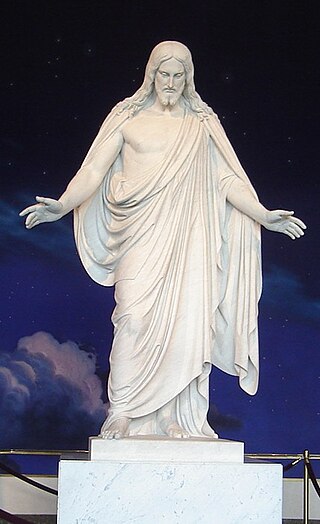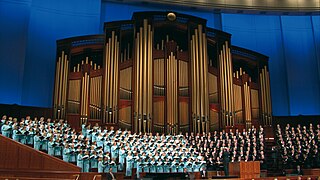
The Relief Society is a philanthropic and educational women's organization of the Church of Jesus Christ of Latter-day Saints. It was founded in 1842 in Nauvoo, Illinois, United States, and has more than 7 million members in over 188 countries and territories. The Relief Society is often referred to by the church and others as "one of the oldest and largest women's organizations in the world."

The Church of Jesus Christ (Cutlerite) is a denomination of the Latter Day Saint movement headquartered in Independence, Missouri, United States. The church derives its epithet from its founder, Alpheus Cutler, a member of the Nauvoo High Council and of Joseph Smith's Council of Fifty. Cutler justified his establishment of an independent church organization by asserting that God had "rejected" Smith's organization—but not his priesthood—following Smith's death, but that Smith had named Cutler to a singular "Quorum of Seven" in anticipation of this event, with a unique prerogative to reorganize the church that no one beyond this group possessed. Hence, Cutler's organization claims to be the only legitimate Latter Day Saint church in the world today. Currently, it has only one branch, located in Independence. The Cutlerite church retains an endowment ceremony believed to date to the Nauvoo period, practices the United Order of Enoch, and accepts baptism for the dead, but not eternal marriage or polygamy.
A stake is an administrative unit composed of multiple congregations in certain denominations of the Latter Day Saint movement. The name "stake" derives from the Book of Isaiah: "enlarge the place of thy tent; stretch forth the curtains of thine habitation; spare not, lengthen thy cords, and strengthen thy stakes". A stake is sometimes referred to as a stake of Zion.

The Latter Day Saint movement is a religious movement within Christianity that arose during the Second Great Awakening in the early 19th century and that led to the set of doctrines, practices, and cultures called Mormonism, and to the existence of numerous Latter Day Saint churches. Its history is characterized by intense controversy and persecution in reaction to some of the movement's doctrines and practices and their relationship to mainstream Christianity. The purpose of this article is to give an overview of the different groups, beliefs, and denominations that began with the influence of Joseph Smith.

The Mormon Trail is the 1,300-mile (2,100 km) long route from Illinois to Utah on which Mormon pioneers traveled from 1846–47. Today, the Mormon Trail is a part of the United States National Trails System, known as the Mormon Pioneer National Historic Trail.

Temple Square is a 10-acre (4.0 ha) complex, owned by the Church of Jesus Christ of Latter-day Saints, in the center of Salt Lake City, Utah. The usage of the name has gradually changed to include several other church facilities that are immediately adjacent to Temple Square. Contained within Temple Square are the Salt Lake Temple, Salt Lake Tabernacle, Salt Lake Assembly Hall, the Seagull Monument, and two visitors' centers. The square was designated a National Historic Landmark District in 1964, recognizing the Mormon achievement in the settlement of Utah.
William Harrison Folsom was an architect and contractor. He constructed many of the historic buildings in Utah, particularly in Salt Lake City. Many of his most prominent works were commissioned by the Church of Jesus Christ of Latter-day Saints. For a time he was sustained as the Church Architect, a calling in the church.

Willard Richards was an early leader in the Latter Day Saint movement. He served as second counselor to church president Brigham Young in the First Presidency of the Church of Jesus Christ of Latter-day Saints from 1847 until his death.

John Alpheus Cutler was an early leader in the Latter Day Saint movement who founded the Church of Jesus Christ (Cutlerite) in 1853. He had previously served in several church positions under Joseph Smith, founder of the Latter Day Saint movement, as well as captain of Smith's personal bodyguard and "Master Builder and Workman on all God's Holy Houses." Following the death of Joseph Smith in June 1844, Cutler at first followed the Twelve Apostles under Brigham Young, but later left Young's church to reorganize the Church of Jesus Christ, with himself serving as its first president. Cutler claimed that this was the sole legitimate continuation of Smith's organization, and he served as its leader until his death.

William Smith was a leader in the Latter Day Saint movement and one of the original members of the Quorum of the Twelve Apostles. Smith was the eighth child of Joseph Smith Sr. and Lucy Mack Smith and was a younger brother of Joseph Smith Jr., the founder of the Latter Day Saint movement.

Mount Pisgah was a semi-permanent settlement or way station from 1846 to 1852 along the Mormon Trail between Garden Grove and Council Bluffs, in the U.S. state of Iowa. It is located near the small community of Thayer in Jones Township, Union County. This site is now part of the Mormon Pioneer National Historic Trail. It is the birthplace of Helaman Pratt. The address of the memorial is 1704 Mount Pisgah Road in Thayer.

Thomas Leiper Kane was an American attorney, abolitionist, philanthropist, and military officer who was influential in the western migration of the Latter-day Saint movement and served as a Union Army colonel and general of volunteers in the American Civil War. He received a brevet promotion to major general for gallantry at the Battle of Gettysburg.

The Nauvoo Brass Band was an official musical organization of the Church of Jesus Christ of Latter Day Saints when the church's headquarters were located in Nauvoo, Illinois. It was later revived by the Church of Jesus Christ of Latter-day Saints in the Utah Territory.

John Pack was a member of the Council of Fifty and a missionary in the early days of the Church of Jesus Christ of Latter-day Saints.

In the Church of Jesus Christ of Latter-day Saints, a temple is a building dedicated to be a House of the Lord. Temples are considered by church members to be the most sacred structures on earth.

Henry William Miller was the first member of the Iowa legislature from the area of Council Bluffs, Iowa.

The following outline is provided as an overview of and a topical guide to the Church of Jesus Christ of Latter-day Saints.

General Conference is a gathering of members of the Church of Jesus Christ of Latter-day Saints, held biannually every April and October at the Conference Center in Salt Lake City, Utah. During each conference, church members gather in a series of two-hour sessions to listen to the faith's leaders.

The Mormon Trail Center at Winter Quarters is a museum and visitors' center of the Church of Jesus Christ of Latter-day Saints located in the Florence neighborhood of Omaha, Nebraska, United States. The museum interprets the story of the Mormon Trail along with the history of a temporary Mormon settlement known as Winter Quarters, which was located in the Florence area between 1846–1848.

Edward Martin was born in 1818 and died in 1882. After joining the Church of Jesus Christ of Latter-day Saints in Britain, he immigrated to the United States and spent much of his life serving in various positions within the church. He is most prominently known for his role as captain of the Martin Handcart Company, a Mormon Handcart Pioneer company that suffered heavy losses when they encountered harsh winter conditions while traveling through Wyoming. He is one of many figures that played a prominent role in the Westward Expansion of the 19th century.


















